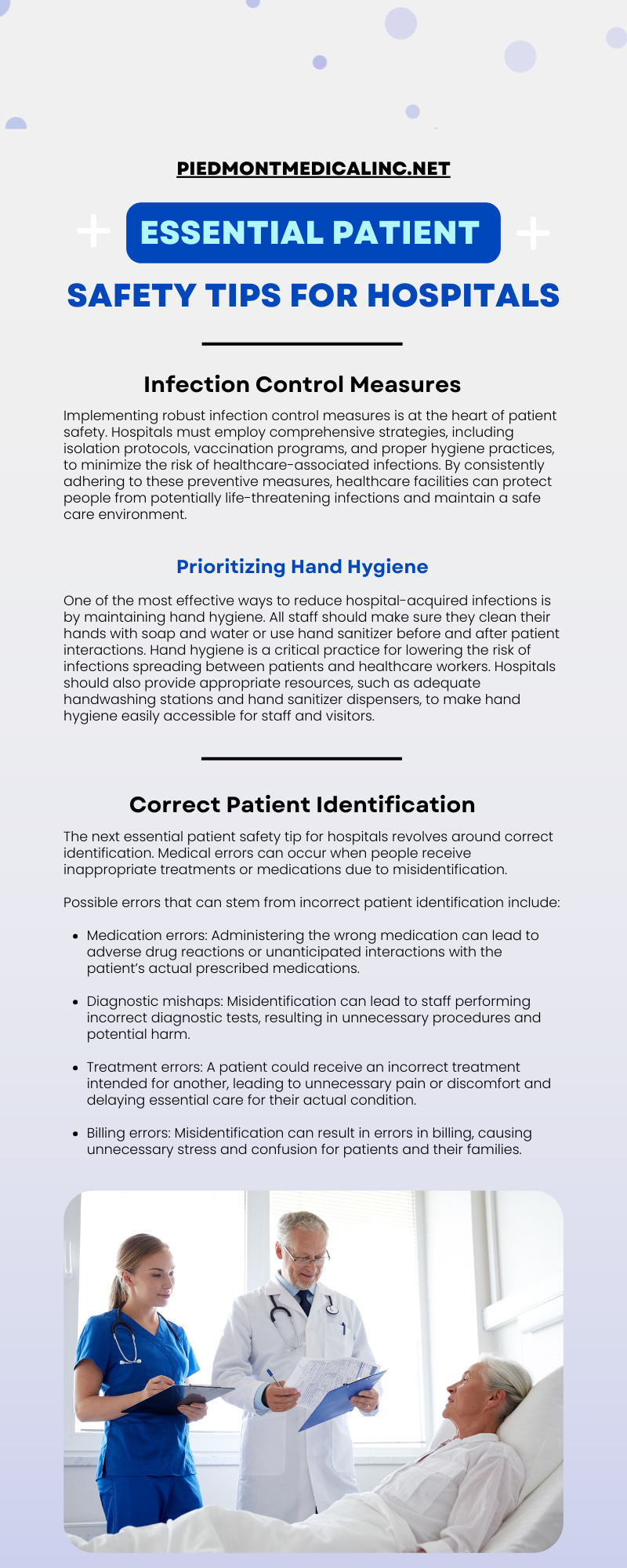Patient safety is a fundamental healthcare principle that focuses on preventing harm caused by errors of care. In hospitals, an established culture of safety among healthcare professionals directly impacts the well-being and health outcomes of patients.
Reducing preventable harm requires a systematic approach ranging from infection control measures to effective communication among healthcare providers. Explore some essential patient safety tips for hospitals and learn how they help ensure every patient receives the best possible care.
Infection Control Measures
Implementing robust infection control measures is at the heart of patient safety. Hospitals must employ comprehensive strategies, including isolation protocols, vaccination programs, and proper hygiene practices, to minimize the risk of healthcare-associated infections. By consistently adhering to these preventive measures, healthcare facilities can protect people from potentially life-threatening infections and maintain a safe care environment.
Prioritizing Hand Hygiene
One of the most effective ways to reduce hospital-acquired infections is by maintaining hand hygiene. All staff should make sure they clean their hands with soap and water or use hand sanitizer before and after patient interactions.
Hand hygiene is a critical practice for lowering the risk of infections spreading between patients and healthcare workers. Hospitals should also provide appropriate resources, such as adequate handwashing stations and hand sanitizer dispensers, to make hand hygiene easily accessible for staff and visitors.
Correct Patient Identification
The next essential patient safety tip for hospitals revolves around correct identification. Medical errors can occur when people receive inappropriate treatments or medications due to misidentification.
Possible errors that can stem from incorrect patient identification include:
- Medication errors: Administering the wrong medication can lead to adverse drug reactions or unanticipated interactions with the patient’s actual prescribed medications.
- Diagnostic mishaps: Misidentification can lead to staff performing incorrect diagnostic tests, resulting in unnecessary procedures and potential harm.
- Treatment errors: A patient could receive an incorrect treatment intended for another, leading to unnecessary pain or discomfort and delaying essential care for their actual condition.
- Billing errors: Misidentification can result in errors in billing, causing unnecessary stress and confusion for patients and their families.
To help prevent these harmful outcomes, hospitals should establish comprehensive processes for verifying individuals’ identities. Examples include the use of wristbands displaying the patient’s name, date of birth, and a unique identification number. Staff should also ask each patient to confirm their identity verbally before any procedure or medication administration.
Fall Prevention Strategies
Falls within hospitals can pose a significant safety risk to patients, particularly for those who already have compromised health or limited mobility. Falling can result in serious injuries like fractures or concussions, exacerbate existing health conditions, prolong hospital stays, and, in worst cases, lead to fatal complications.
Therefore, incorporating fall prevention strategies is vital to maintaining a safe environment. Hospitals should assess each individual’s risk of falling and ensure that appropriate measures, such as handrails, non-slip flooring, and proper lighting, are in place to reduce fall hazards. Additionally, hospitals should educate patients, their families, and the hospital staff on the importance of fall prevention.
Purchasing Fall-Preventing Hospital Beds
A hospital bed designed with safety in mind can significantly help prevent falls. For example, Stryker hospital furniture includes easy-to-use railings that help patients get in and out of bed safely. Additionally, lockable wheels prevent the bed from moving unexpectedly, thereby reducing the risk of falls.
Regular Equipment Maintenance
Medical equipment is used to diagnose, monitor, and treat conditions, making it an integral part of healthcare. Any device malfunction or failure can have severe consequences for both patients and healthcare professionals. If medical equipment malfunctions or fails, it could lead to misdiagnosis, delayed treatment, or, in extreme cases, life-threatening situations.
By performing regular maintenance, you can identify potential issues early on and address them before they cause any harm. Hospitals should establish a schedule for equipment inspections, maintenance, and replacement. Medical facilities should also train all staff on proper equipment usage and maintenance.
The Use of Electronic Health Records
Effective use of electronic health records (EHRs) significantly contributes to patient safety by reducing the chances of medication errors and streamlining care coordination. EHRs allow healthcare providers to access comprehensive medical information and make informed decisions, ensuring that patients receive the right medications and treatments at the right time.
Moreover, EHRs facilitate clear communication between healthcare professionals and improve collaboration, leading to better health outcomes. Healthcare professionals should always ensure they enter accurate data into EHRs and update those records regularly, as any misinformation can lead to harmful medical errors.
Open Communication
Fostering a culture of open communication plays a pivotal role in improving safety. By encouraging error reporting and constructive feedback, healthcare professionals can proactively address potential safety issues and identify areas for improvement.
Open communication empowers staff to share their concerns and experiences and learn from each other, leading to innovative solutions that enhance patient safety and overall quality of care. Effective communication can enhance employee coordination, morale, and satisfaction.
Improving Staff Communication
To foster open communication among hospital staff, establish a blame-free environment where individuals can feel comfortable reporting errors or safety concerns without fear of retribution. In regular team meetings, encourage all staff, regardless of their position, to voice their thoughts and ideas. Additionally, consider using a communication framework such as SBAR (Situation, Background, Assessment, Recommendation) to standardize processes and ensure the accurate transfer of information.
Safe Transitions of Care
Transitions of care occur when a patient is moved from one healthcare setting to another, such as from a hospital to a rehabilitation center or from inpatient care to home care. These transitions are necessary when care needs change due to their condition’s improvement or deterioration, ensuring the patient receives appropriate and continuous care.
Preventing adverse events and delivering high-quality care depend on safe and effective transitions of care. Healthcare professionals must ensure they accurately communicate essential information, such as medications, medical history, and care plans. By incorporating standardized tools and checklists, healthcare providers can minimize the risk of lapses in communication and ensure that patient safety remains at the forefront during these critical moments.
Reducing harm is a cornerstone of quality healthcare and should be a top priority in every facility. By adopting strategies such as robust infection control measures, correct patient identification, fall prevention, regular equipment maintenance, open communication, and safe transitions of care, medical teams can significantly reduce the risk of preventable harm.
These practices require diligence, commitment, and a culture of safety among healthcare professionals. Individuals and teams that make a conscious effort to prioritize patient safety and foster a culture of continuous improvement ultimately enhance care quality.



Recent Comments